Positive Learning Environment: Reflection and Management Plan
VerifiedAdded on 2022/12/19
|11
|3445
|41
Report
AI Summary
This report analyzes a classroom observation, focusing on a civics class where students displayed disruptive behavior. The author, a pre-service teacher, describes the situation, analyzes the underlying reasons for the students' disengagement, and reflects on the teacher's actions and the author's intervention. The analysis considers the traditional teaching methods versus modern approaches, the importance of teacher-student connection, and the impact of classroom environment. The author then proposes transformative strategies to improve the learning environment, emphasizing the need for interactive sessions, polite and calm demeanor, free flow of information, validation of effort, and creating a sense of belonging. The report concludes with the development of a classroom management plan, including preventative and corrective strategies, to promote a safe and positive learning environment, considering cultural, linguistic, and ability differences, as well as the use of resources, communication, and technology.
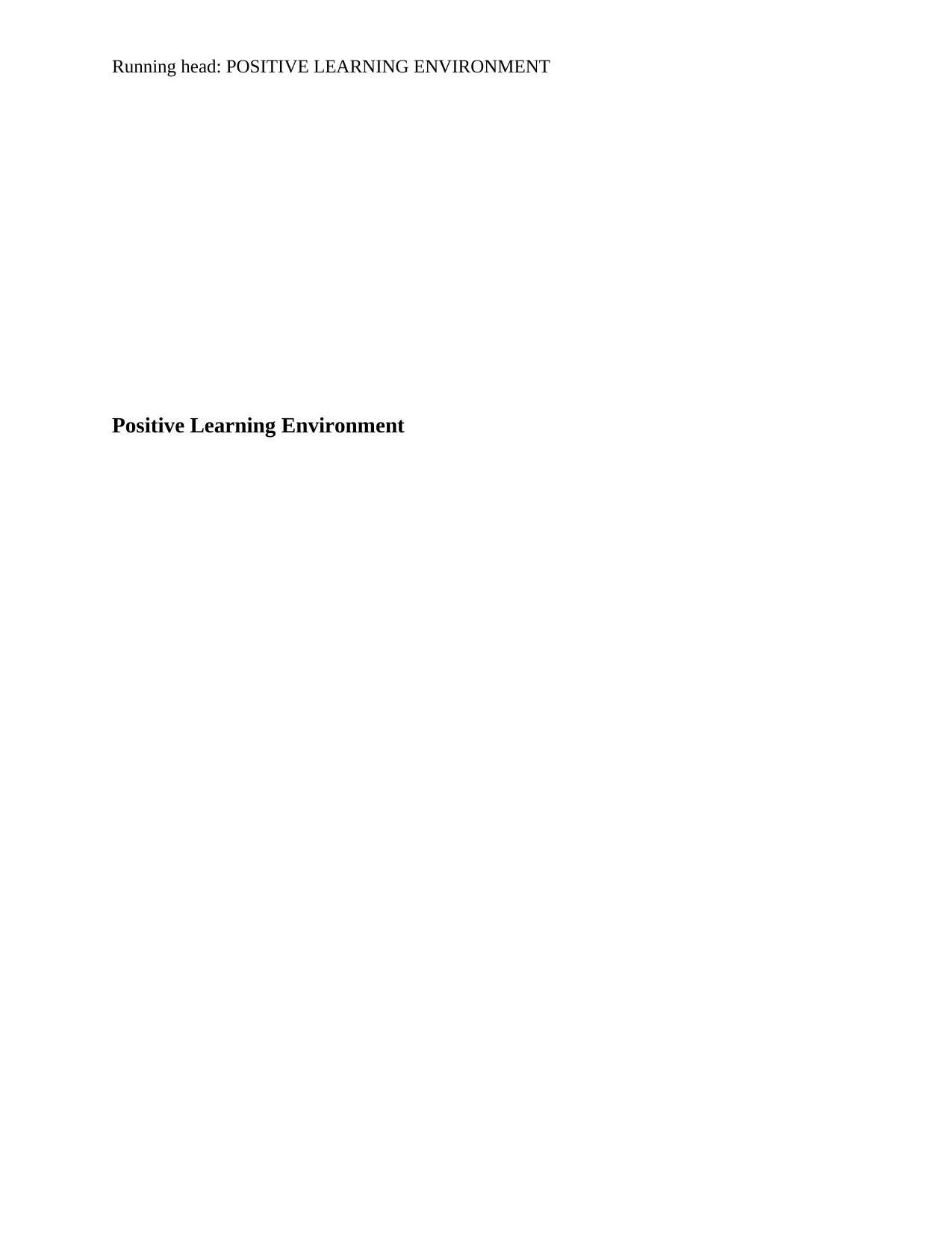
Running head: POSITIVE LEARNING ENVIRONMENT
Positive Learning Environment
Positive Learning Environment
Paraphrase This Document
Need a fresh take? Get an instant paraphrase of this document with our AI Paraphraser
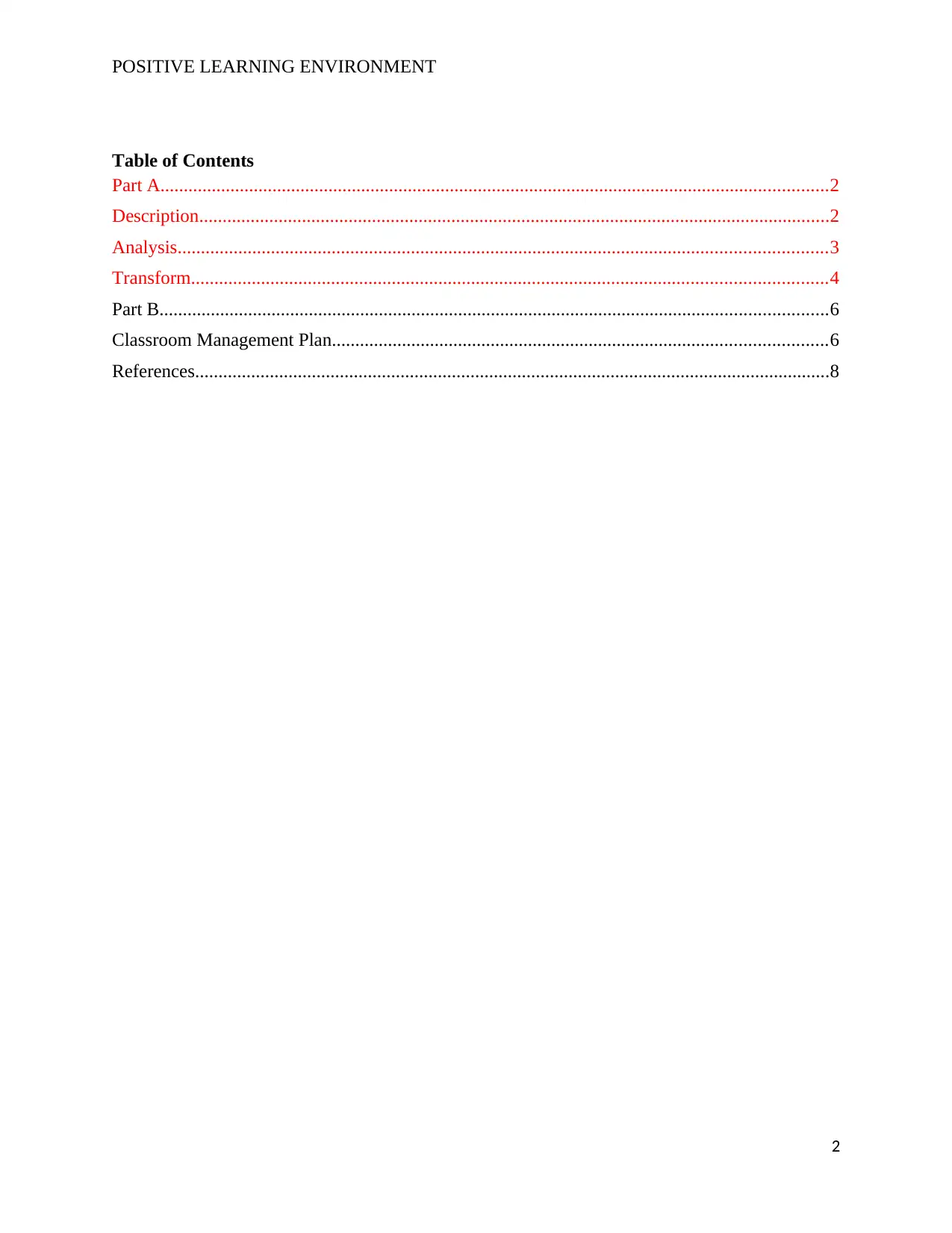
POSITIVE LEARNING ENVIRONMENT
Table of Contents
Part A...............................................................................................................................................2
Description.......................................................................................................................................2
Analysis...........................................................................................................................................3
Transform........................................................................................................................................4
Part B...............................................................................................................................................6
Classroom Management Plan..........................................................................................................6
References........................................................................................................................................8
2
Table of Contents
Part A...............................................................................................................................................2
Description.......................................................................................................................................2
Analysis...........................................................................................................................................3
Transform........................................................................................................................................4
Part B...............................................................................................................................................6
Classroom Management Plan..........................................................................................................6
References........................................................................................................................................8
2
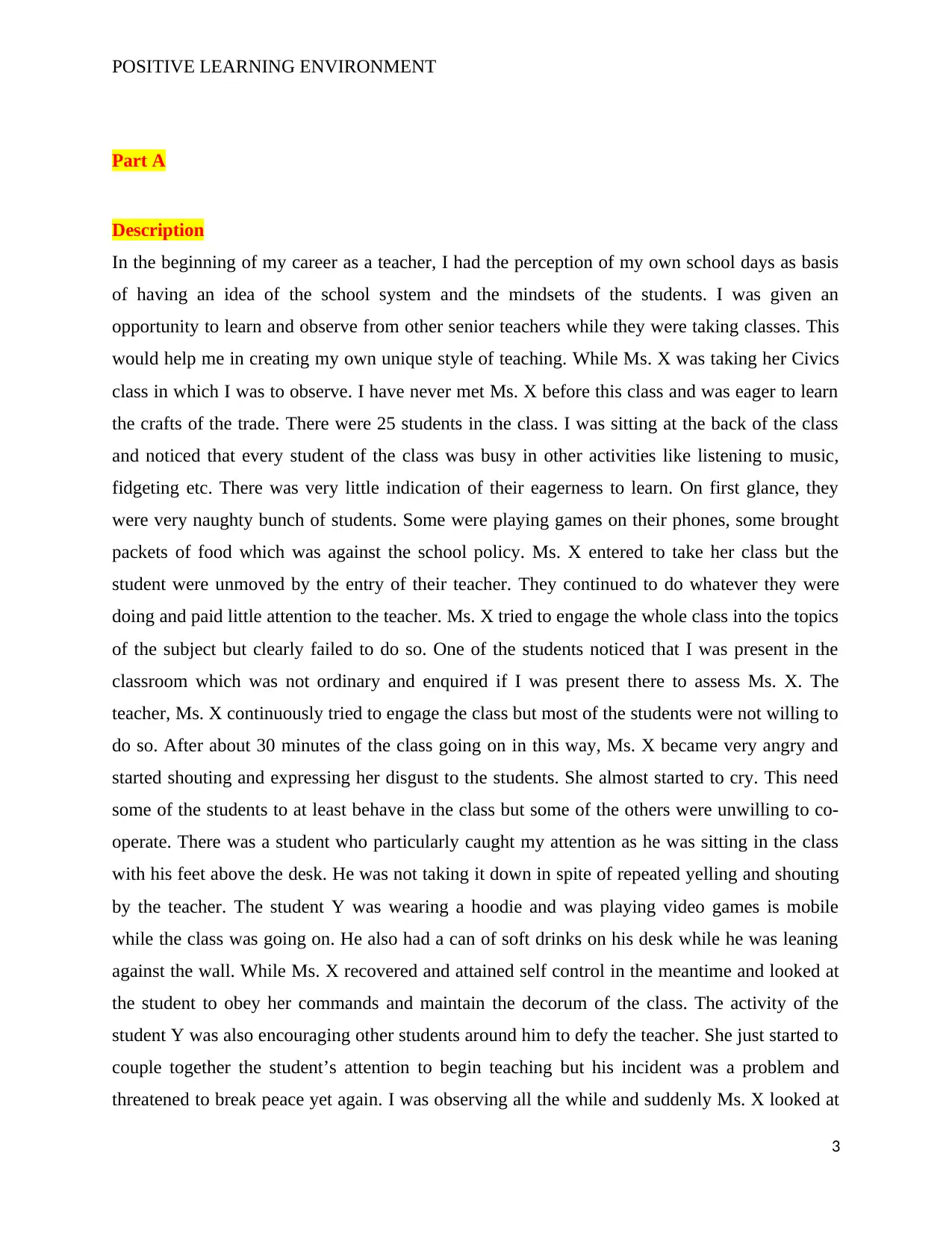
POSITIVE LEARNING ENVIRONMENT
Part A
Description
In the beginning of my career as a teacher, I had the perception of my own school days as basis
of having an idea of the school system and the mindsets of the students. I was given an
opportunity to learn and observe from other senior teachers while they were taking classes. This
would help me in creating my own unique style of teaching. While Ms. X was taking her Civics
class in which I was to observe. I have never met Ms. X before this class and was eager to learn
the crafts of the trade. There were 25 students in the class. I was sitting at the back of the class
and noticed that every student of the class was busy in other activities like listening to music,
fidgeting etc. There was very little indication of their eagerness to learn. On first glance, they
were very naughty bunch of students. Some were playing games on their phones, some brought
packets of food which was against the school policy. Ms. X entered to take her class but the
student were unmoved by the entry of their teacher. They continued to do whatever they were
doing and paid little attention to the teacher. Ms. X tried to engage the whole class into the topics
of the subject but clearly failed to do so. One of the students noticed that I was present in the
classroom which was not ordinary and enquired if I was present there to assess Ms. X. The
teacher, Ms. X continuously tried to engage the class but most of the students were not willing to
do so. After about 30 minutes of the class going on in this way, Ms. X became very angry and
started shouting and expressing her disgust to the students. She almost started to cry. This need
some of the students to at least behave in the class but some of the others were unwilling to co-
operate. There was a student who particularly caught my attention as he was sitting in the class
with his feet above the desk. He was not taking it down in spite of repeated yelling and shouting
by the teacher. The student Y was wearing a hoodie and was playing video games is mobile
while the class was going on. He also had a can of soft drinks on his desk while he was leaning
against the wall. While Ms. X recovered and attained self control in the meantime and looked at
the student to obey her commands and maintain the decorum of the class. The activity of the
student Y was also encouraging other students around him to defy the teacher. She just started to
couple together the student’s attention to begin teaching but his incident was a problem and
threatened to break peace yet again. I was observing all the while and suddenly Ms. X looked at
3
Part A
Description
In the beginning of my career as a teacher, I had the perception of my own school days as basis
of having an idea of the school system and the mindsets of the students. I was given an
opportunity to learn and observe from other senior teachers while they were taking classes. This
would help me in creating my own unique style of teaching. While Ms. X was taking her Civics
class in which I was to observe. I have never met Ms. X before this class and was eager to learn
the crafts of the trade. There were 25 students in the class. I was sitting at the back of the class
and noticed that every student of the class was busy in other activities like listening to music,
fidgeting etc. There was very little indication of their eagerness to learn. On first glance, they
were very naughty bunch of students. Some were playing games on their phones, some brought
packets of food which was against the school policy. Ms. X entered to take her class but the
student were unmoved by the entry of their teacher. They continued to do whatever they were
doing and paid little attention to the teacher. Ms. X tried to engage the whole class into the topics
of the subject but clearly failed to do so. One of the students noticed that I was present in the
classroom which was not ordinary and enquired if I was present there to assess Ms. X. The
teacher, Ms. X continuously tried to engage the class but most of the students were not willing to
do so. After about 30 minutes of the class going on in this way, Ms. X became very angry and
started shouting and expressing her disgust to the students. She almost started to cry. This need
some of the students to at least behave in the class but some of the others were unwilling to co-
operate. There was a student who particularly caught my attention as he was sitting in the class
with his feet above the desk. He was not taking it down in spite of repeated yelling and shouting
by the teacher. The student Y was wearing a hoodie and was playing video games is mobile
while the class was going on. He also had a can of soft drinks on his desk while he was leaning
against the wall. While Ms. X recovered and attained self control in the meantime and looked at
the student to obey her commands and maintain the decorum of the class. The activity of the
student Y was also encouraging other students around him to defy the teacher. She just started to
couple together the student’s attention to begin teaching but his incident was a problem and
threatened to break peace yet again. I was observing all the while and suddenly Ms. X looked at
3
⊘ This is a preview!⊘
Do you want full access?
Subscribe today to unlock all pages.

Trusted by 1+ million students worldwide
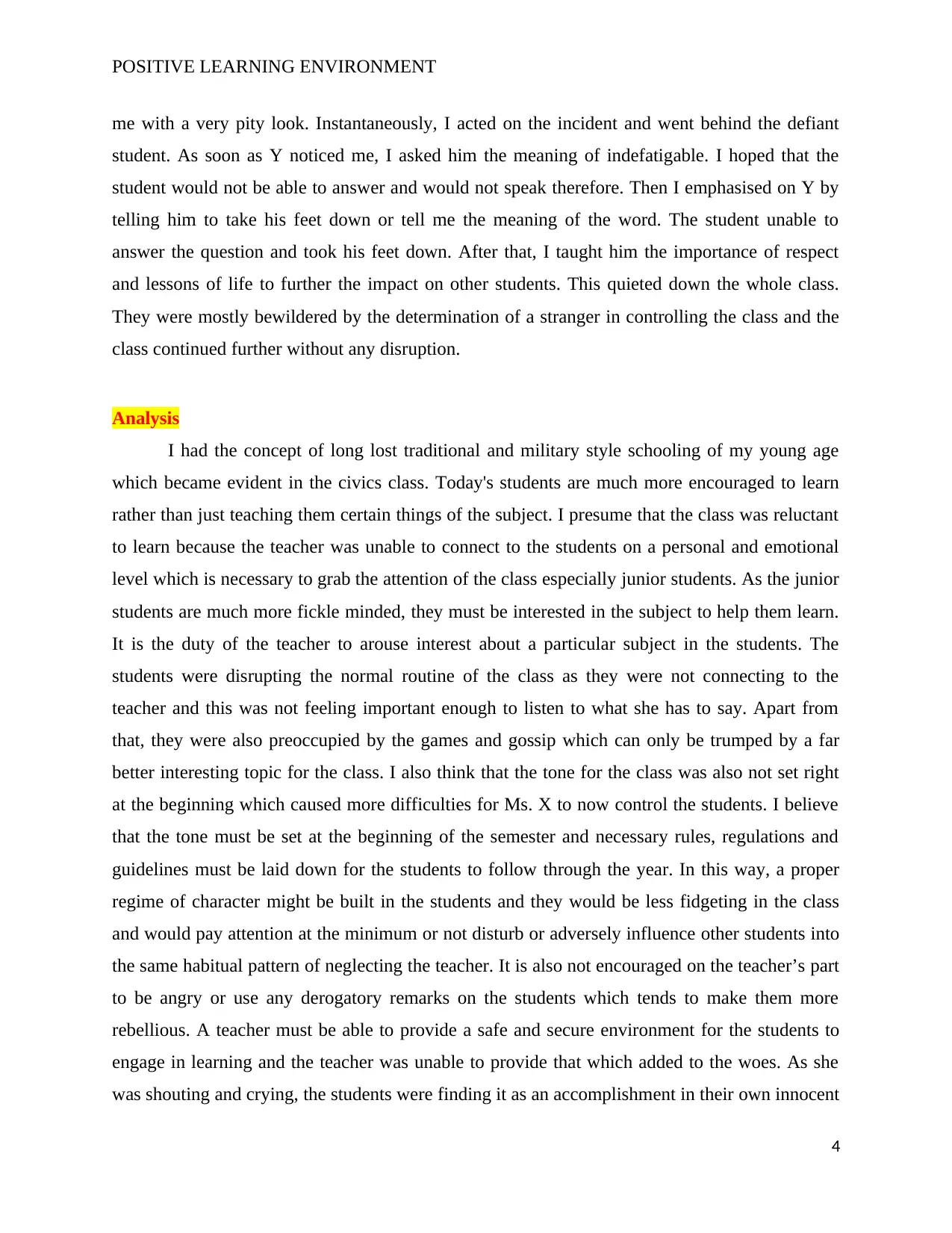
POSITIVE LEARNING ENVIRONMENT
me with a very pity look. Instantaneously, I acted on the incident and went behind the defiant
student. As soon as Y noticed me, I asked him the meaning of indefatigable. I hoped that the
student would not be able to answer and would not speak therefore. Then I emphasised on Y by
telling him to take his feet down or tell me the meaning of the word. The student unable to
answer the question and took his feet down. After that, I taught him the importance of respect
and lessons of life to further the impact on other students. This quieted down the whole class.
They were mostly bewildered by the determination of a stranger in controlling the class and the
class continued further without any disruption.
Analysis
I had the concept of long lost traditional and military style schooling of my young age
which became evident in the civics class. Today's students are much more encouraged to learn
rather than just teaching them certain things of the subject. I presume that the class was reluctant
to learn because the teacher was unable to connect to the students on a personal and emotional
level which is necessary to grab the attention of the class especially junior students. As the junior
students are much more fickle minded, they must be interested in the subject to help them learn.
It is the duty of the teacher to arouse interest about a particular subject in the students. The
students were disrupting the normal routine of the class as they were not connecting to the
teacher and this was not feeling important enough to listen to what she has to say. Apart from
that, they were also preoccupied by the games and gossip which can only be trumped by a far
better interesting topic for the class. I also think that the tone for the class was also not set right
at the beginning which caused more difficulties for Ms. X to now control the students. I believe
that the tone must be set at the beginning of the semester and necessary rules, regulations and
guidelines must be laid down for the students to follow through the year. In this way, a proper
regime of character might be built in the students and they would be less fidgeting in the class
and would pay attention at the minimum or not disturb or adversely influence other students into
the same habitual pattern of neglecting the teacher. It is also not encouraged on the teacher’s part
to be angry or use any derogatory remarks on the students which tends to make them more
rebellious. A teacher must be able to provide a safe and secure environment for the students to
engage in learning and the teacher was unable to provide that which added to the woes. As she
was shouting and crying, the students were finding it as an accomplishment in their own innocent
4
me with a very pity look. Instantaneously, I acted on the incident and went behind the defiant
student. As soon as Y noticed me, I asked him the meaning of indefatigable. I hoped that the
student would not be able to answer and would not speak therefore. Then I emphasised on Y by
telling him to take his feet down or tell me the meaning of the word. The student unable to
answer the question and took his feet down. After that, I taught him the importance of respect
and lessons of life to further the impact on other students. This quieted down the whole class.
They were mostly bewildered by the determination of a stranger in controlling the class and the
class continued further without any disruption.
Analysis
I had the concept of long lost traditional and military style schooling of my young age
which became evident in the civics class. Today's students are much more encouraged to learn
rather than just teaching them certain things of the subject. I presume that the class was reluctant
to learn because the teacher was unable to connect to the students on a personal and emotional
level which is necessary to grab the attention of the class especially junior students. As the junior
students are much more fickle minded, they must be interested in the subject to help them learn.
It is the duty of the teacher to arouse interest about a particular subject in the students. The
students were disrupting the normal routine of the class as they were not connecting to the
teacher and this was not feeling important enough to listen to what she has to say. Apart from
that, they were also preoccupied by the games and gossip which can only be trumped by a far
better interesting topic for the class. I also think that the tone for the class was also not set right
at the beginning which caused more difficulties for Ms. X to now control the students. I believe
that the tone must be set at the beginning of the semester and necessary rules, regulations and
guidelines must be laid down for the students to follow through the year. In this way, a proper
regime of character might be built in the students and they would be less fidgeting in the class
and would pay attention at the minimum or not disturb or adversely influence other students into
the same habitual pattern of neglecting the teacher. It is also not encouraged on the teacher’s part
to be angry or use any derogatory remarks on the students which tends to make them more
rebellious. A teacher must be able to provide a safe and secure environment for the students to
engage in learning and the teacher was unable to provide that which added to the woes. As she
was shouting and crying, the students were finding it as an accomplishment in their own innocent
4
Paraphrase This Document
Need a fresh take? Get an instant paraphrase of this document with our AI Paraphraser
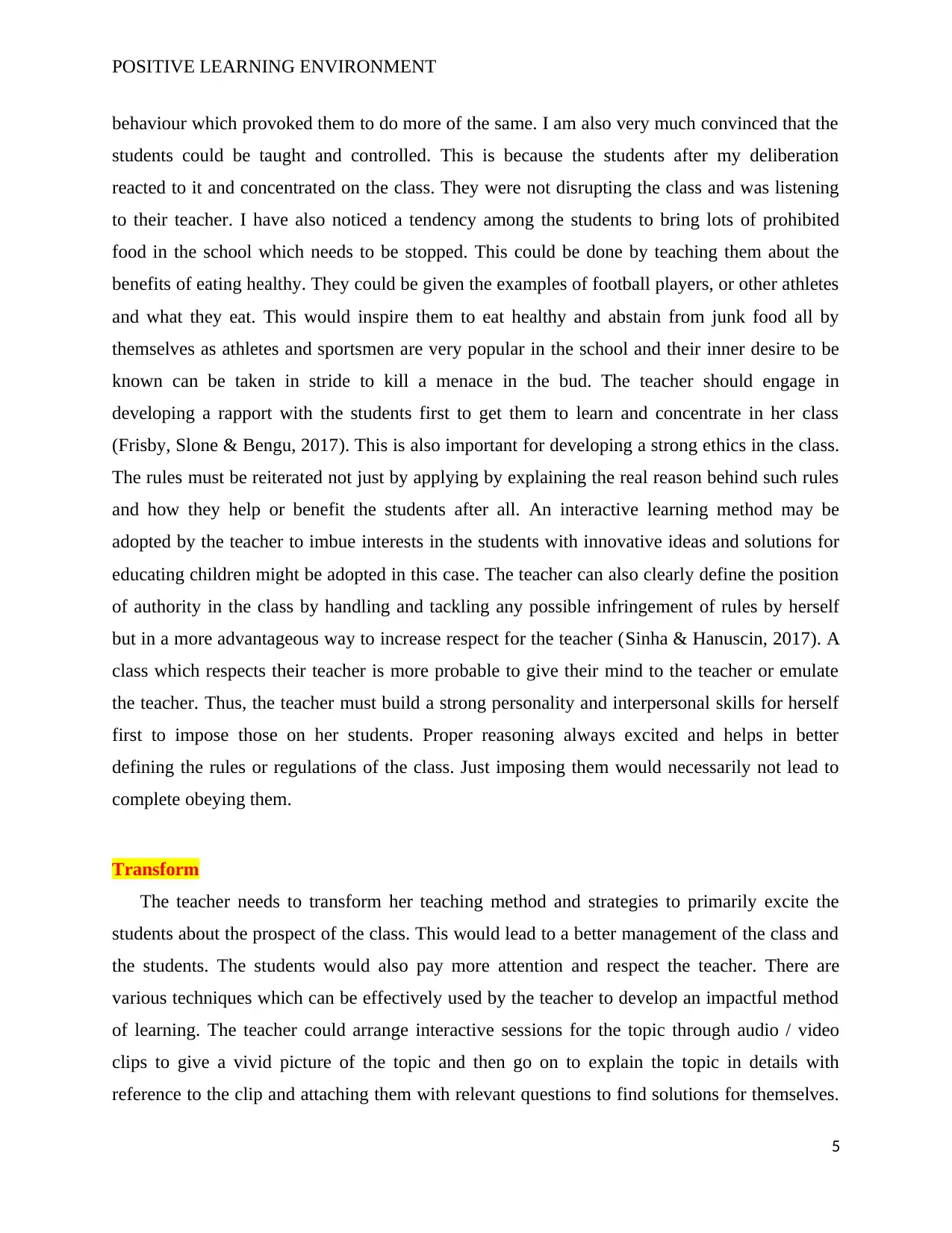
POSITIVE LEARNING ENVIRONMENT
behaviour which provoked them to do more of the same. I am also very much convinced that the
students could be taught and controlled. This is because the students after my deliberation
reacted to it and concentrated on the class. They were not disrupting the class and was listening
to their teacher. I have also noticed a tendency among the students to bring lots of prohibited
food in the school which needs to be stopped. This could be done by teaching them about the
benefits of eating healthy. They could be given the examples of football players, or other athletes
and what they eat. This would inspire them to eat healthy and abstain from junk food all by
themselves as athletes and sportsmen are very popular in the school and their inner desire to be
known can be taken in stride to kill a menace in the bud. The teacher should engage in
developing a rapport with the students first to get them to learn and concentrate in her class
(Frisby, Slone & Bengu, 2017). This is also important for developing a strong ethics in the class.
The rules must be reiterated not just by applying by explaining the real reason behind such rules
and how they help or benefit the students after all. An interactive learning method may be
adopted by the teacher to imbue interests in the students with innovative ideas and solutions for
educating children might be adopted in this case. The teacher can also clearly define the position
of authority in the class by handling and tackling any possible infringement of rules by herself
but in a more advantageous way to increase respect for the teacher (Sinha & Hanuscin, 2017). A
class which respects their teacher is more probable to give their mind to the teacher or emulate
the teacher. Thus, the teacher must build a strong personality and interpersonal skills for herself
first to impose those on her students. Proper reasoning always excited and helps in better
defining the rules or regulations of the class. Just imposing them would necessarily not lead to
complete obeying them.
Transform
The teacher needs to transform her teaching method and strategies to primarily excite the
students about the prospect of the class. This would lead to a better management of the class and
the students. The students would also pay more attention and respect the teacher. There are
various techniques which can be effectively used by the teacher to develop an impactful method
of learning. The teacher could arrange interactive sessions for the topic through audio / video
clips to give a vivid picture of the topic and then go on to explain the topic in details with
reference to the clip and attaching them with relevant questions to find solutions for themselves.
5
behaviour which provoked them to do more of the same. I am also very much convinced that the
students could be taught and controlled. This is because the students after my deliberation
reacted to it and concentrated on the class. They were not disrupting the class and was listening
to their teacher. I have also noticed a tendency among the students to bring lots of prohibited
food in the school which needs to be stopped. This could be done by teaching them about the
benefits of eating healthy. They could be given the examples of football players, or other athletes
and what they eat. This would inspire them to eat healthy and abstain from junk food all by
themselves as athletes and sportsmen are very popular in the school and their inner desire to be
known can be taken in stride to kill a menace in the bud. The teacher should engage in
developing a rapport with the students first to get them to learn and concentrate in her class
(Frisby, Slone & Bengu, 2017). This is also important for developing a strong ethics in the class.
The rules must be reiterated not just by applying by explaining the real reason behind such rules
and how they help or benefit the students after all. An interactive learning method may be
adopted by the teacher to imbue interests in the students with innovative ideas and solutions for
educating children might be adopted in this case. The teacher can also clearly define the position
of authority in the class by handling and tackling any possible infringement of rules by herself
but in a more advantageous way to increase respect for the teacher (Sinha & Hanuscin, 2017). A
class which respects their teacher is more probable to give their mind to the teacher or emulate
the teacher. Thus, the teacher must build a strong personality and interpersonal skills for herself
first to impose those on her students. Proper reasoning always excited and helps in better
defining the rules or regulations of the class. Just imposing them would necessarily not lead to
complete obeying them.
Transform
The teacher needs to transform her teaching method and strategies to primarily excite the
students about the prospect of the class. This would lead to a better management of the class and
the students. The students would also pay more attention and respect the teacher. There are
various techniques which can be effectively used by the teacher to develop an impactful method
of learning. The teacher could arrange interactive sessions for the topic through audio / video
clips to give a vivid picture of the topic and then go on to explain the topic in details with
reference to the clip and attaching them with relevant questions to find solutions for themselves.
5
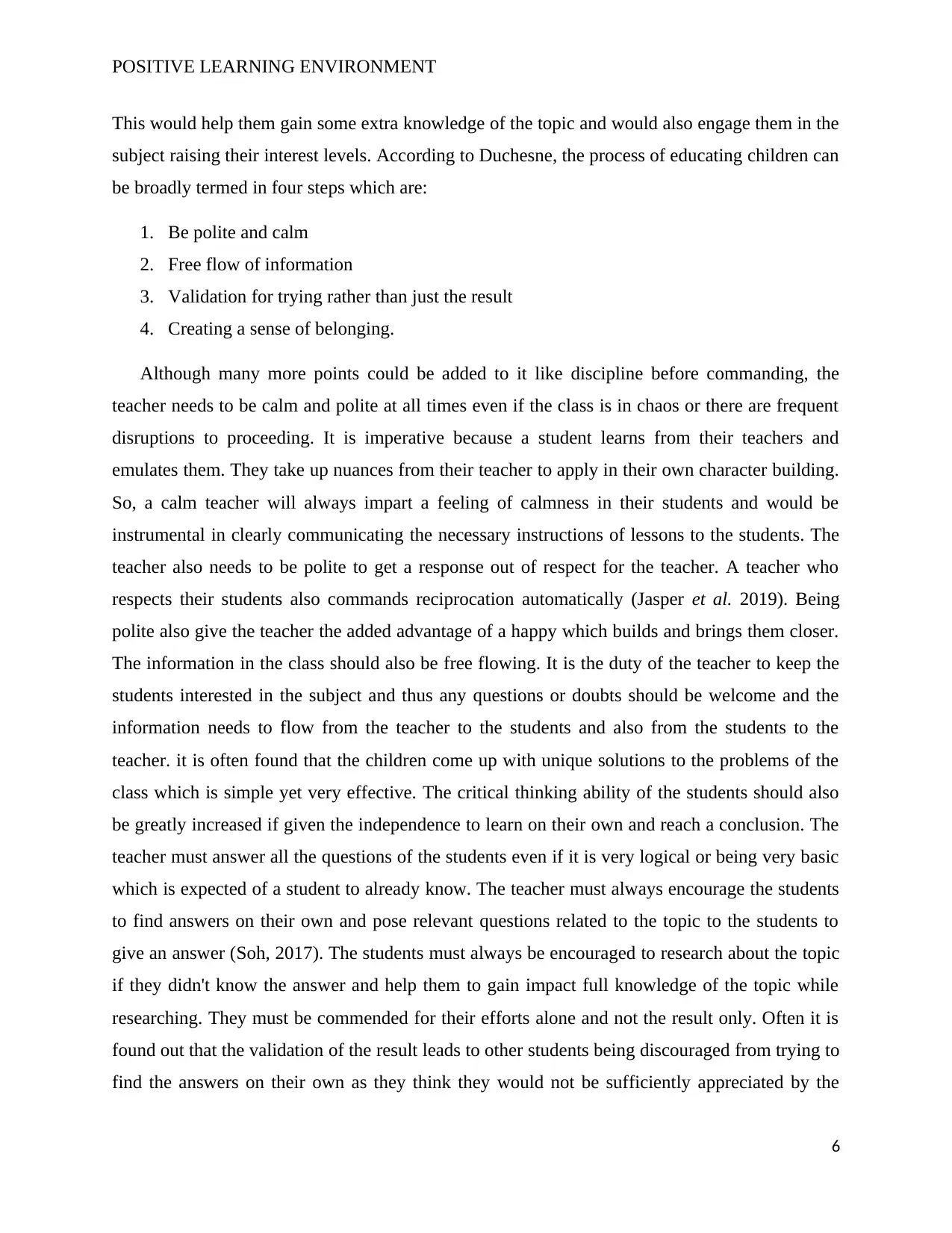
POSITIVE LEARNING ENVIRONMENT
This would help them gain some extra knowledge of the topic and would also engage them in the
subject raising their interest levels. According to Duchesne, the process of educating children can
be broadly termed in four steps which are:
1. Be polite and calm
2. Free flow of information
3. Validation for trying rather than just the result
4. Creating a sense of belonging.
Although many more points could be added to it like discipline before commanding, the
teacher needs to be calm and polite at all times even if the class is in chaos or there are frequent
disruptions to proceeding. It is imperative because a student learns from their teachers and
emulates them. They take up nuances from their teacher to apply in their own character building.
So, a calm teacher will always impart a feeling of calmness in their students and would be
instrumental in clearly communicating the necessary instructions of lessons to the students. The
teacher also needs to be polite to get a response out of respect for the teacher. A teacher who
respects their students also commands reciprocation automatically (Jasper et al. 2019). Being
polite also give the teacher the added advantage of a happy which builds and brings them closer.
The information in the class should also be free flowing. It is the duty of the teacher to keep the
students interested in the subject and thus any questions or doubts should be welcome and the
information needs to flow from the teacher to the students and also from the students to the
teacher. it is often found that the children come up with unique solutions to the problems of the
class which is simple yet very effective. The critical thinking ability of the students should also
be greatly increased if given the independence to learn on their own and reach a conclusion. The
teacher must answer all the questions of the students even if it is very logical or being very basic
which is expected of a student to already know. The teacher must always encourage the students
to find answers on their own and pose relevant questions related to the topic to the students to
give an answer (Soh, 2017). The students must always be encouraged to research about the topic
if they didn't know the answer and help them to gain impact full knowledge of the topic while
researching. They must be commended for their efforts alone and not the result only. Often it is
found out that the validation of the result leads to other students being discouraged from trying to
find the answers on their own as they think they would not be sufficiently appreciated by the
6
This would help them gain some extra knowledge of the topic and would also engage them in the
subject raising their interest levels. According to Duchesne, the process of educating children can
be broadly termed in four steps which are:
1. Be polite and calm
2. Free flow of information
3. Validation for trying rather than just the result
4. Creating a sense of belonging.
Although many more points could be added to it like discipline before commanding, the
teacher needs to be calm and polite at all times even if the class is in chaos or there are frequent
disruptions to proceeding. It is imperative because a student learns from their teachers and
emulates them. They take up nuances from their teacher to apply in their own character building.
So, a calm teacher will always impart a feeling of calmness in their students and would be
instrumental in clearly communicating the necessary instructions of lessons to the students. The
teacher also needs to be polite to get a response out of respect for the teacher. A teacher who
respects their students also commands reciprocation automatically (Jasper et al. 2019). Being
polite also give the teacher the added advantage of a happy which builds and brings them closer.
The information in the class should also be free flowing. It is the duty of the teacher to keep the
students interested in the subject and thus any questions or doubts should be welcome and the
information needs to flow from the teacher to the students and also from the students to the
teacher. it is often found that the children come up with unique solutions to the problems of the
class which is simple yet very effective. The critical thinking ability of the students should also
be greatly increased if given the independence to learn on their own and reach a conclusion. The
teacher must answer all the questions of the students even if it is very logical or being very basic
which is expected of a student to already know. The teacher must always encourage the students
to find answers on their own and pose relevant questions related to the topic to the students to
give an answer (Soh, 2017). The students must always be encouraged to research about the topic
if they didn't know the answer and help them to gain impact full knowledge of the topic while
researching. They must be commended for their efforts alone and not the result only. Often it is
found out that the validation of the result leads to other students being discouraged from trying to
find the answers on their own as they think they would not be sufficiently appreciated by the
6
⊘ This is a preview!⊘
Do you want full access?
Subscribe today to unlock all pages.

Trusted by 1+ million students worldwide
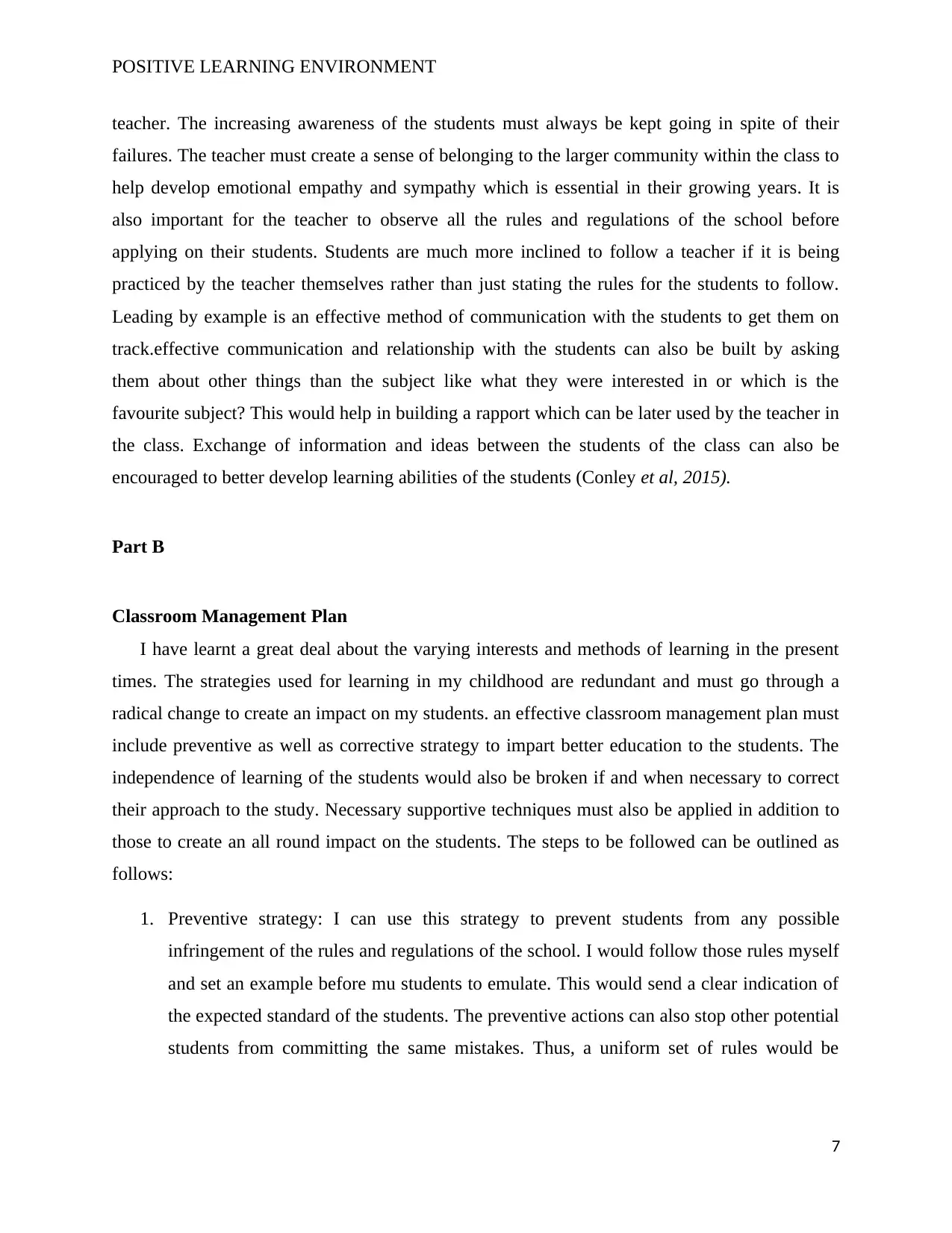
POSITIVE LEARNING ENVIRONMENT
teacher. The increasing awareness of the students must always be kept going in spite of their
failures. The teacher must create a sense of belonging to the larger community within the class to
help develop emotional empathy and sympathy which is essential in their growing years. It is
also important for the teacher to observe all the rules and regulations of the school before
applying on their students. Students are much more inclined to follow a teacher if it is being
practiced by the teacher themselves rather than just stating the rules for the students to follow.
Leading by example is an effective method of communication with the students to get them on
track.effective communication and relationship with the students can also be built by asking
them about other things than the subject like what they were interested in or which is the
favourite subject? This would help in building a rapport which can be later used by the teacher in
the class. Exchange of information and ideas between the students of the class can also be
encouraged to better develop learning abilities of the students (Conley et al, 2015).
Part B
Classroom Management Plan
I have learnt a great deal about the varying interests and methods of learning in the present
times. The strategies used for learning in my childhood are redundant and must go through a
radical change to create an impact on my students. an effective classroom management plan must
include preventive as well as corrective strategy to impart better education to the students. The
independence of learning of the students would also be broken if and when necessary to correct
their approach to the study. Necessary supportive techniques must also be applied in addition to
those to create an all round impact on the students. The steps to be followed can be outlined as
follows:
1. Preventive strategy: I can use this strategy to prevent students from any possible
infringement of the rules and regulations of the school. I would follow those rules myself
and set an example before mu students to emulate. This would send a clear indication of
the expected standard of the students. The preventive actions can also stop other potential
students from committing the same mistakes. Thus, a uniform set of rules would be
7
teacher. The increasing awareness of the students must always be kept going in spite of their
failures. The teacher must create a sense of belonging to the larger community within the class to
help develop emotional empathy and sympathy which is essential in their growing years. It is
also important for the teacher to observe all the rules and regulations of the school before
applying on their students. Students are much more inclined to follow a teacher if it is being
practiced by the teacher themselves rather than just stating the rules for the students to follow.
Leading by example is an effective method of communication with the students to get them on
track.effective communication and relationship with the students can also be built by asking
them about other things than the subject like what they were interested in or which is the
favourite subject? This would help in building a rapport which can be later used by the teacher in
the class. Exchange of information and ideas between the students of the class can also be
encouraged to better develop learning abilities of the students (Conley et al, 2015).
Part B
Classroom Management Plan
I have learnt a great deal about the varying interests and methods of learning in the present
times. The strategies used for learning in my childhood are redundant and must go through a
radical change to create an impact on my students. an effective classroom management plan must
include preventive as well as corrective strategy to impart better education to the students. The
independence of learning of the students would also be broken if and when necessary to correct
their approach to the study. Necessary supportive techniques must also be applied in addition to
those to create an all round impact on the students. The steps to be followed can be outlined as
follows:
1. Preventive strategy: I can use this strategy to prevent students from any possible
infringement of the rules and regulations of the school. I would follow those rules myself
and set an example before mu students to emulate. This would send a clear indication of
the expected standard of the students. The preventive actions can also stop other potential
students from committing the same mistakes. Thus, a uniform set of rules would be
7
Paraphrase This Document
Need a fresh take? Get an instant paraphrase of this document with our AI Paraphraser
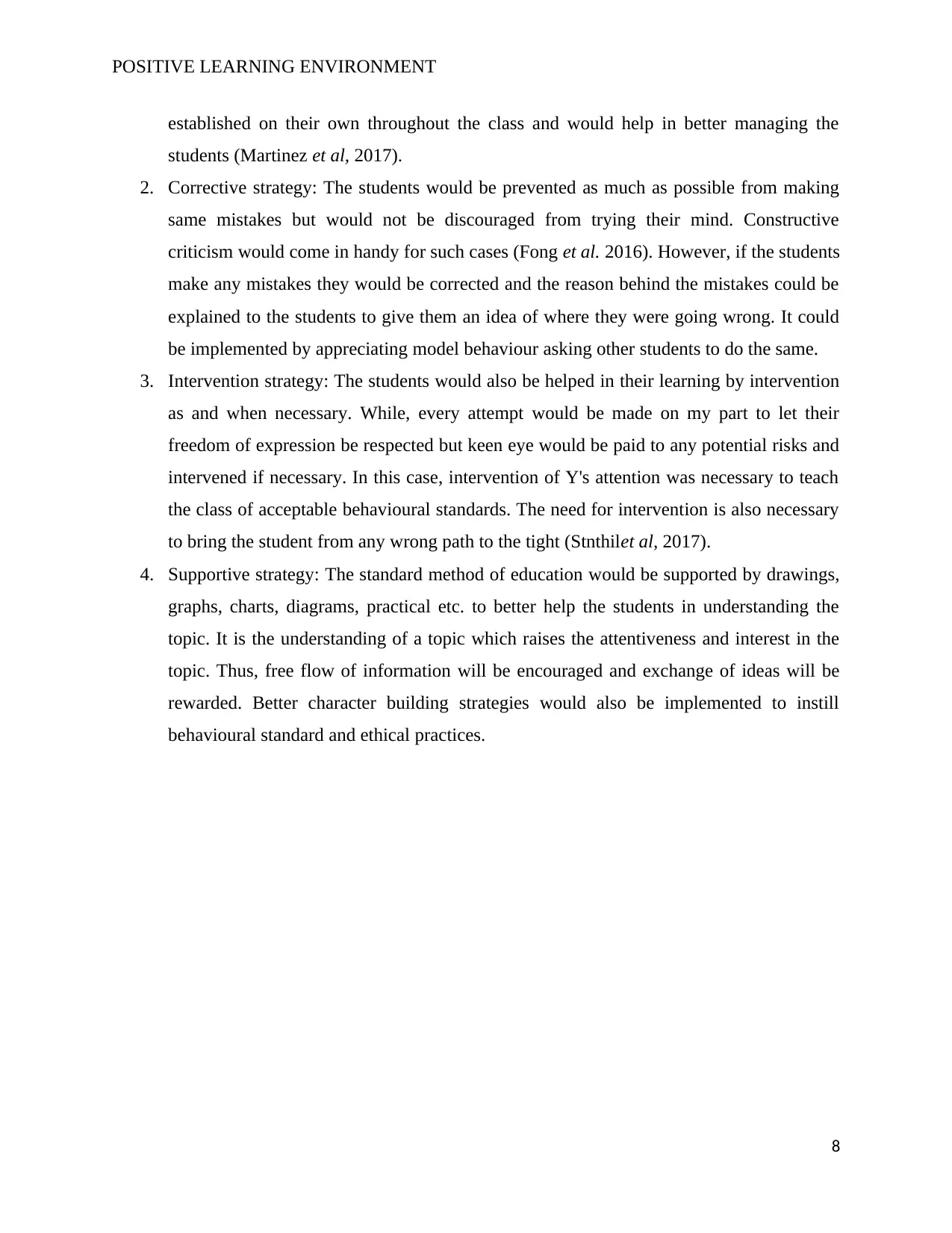
POSITIVE LEARNING ENVIRONMENT
established on their own throughout the class and would help in better managing the
students (Martinez et al, 2017).
2. Corrective strategy: The students would be prevented as much as possible from making
same mistakes but would not be discouraged from trying their mind. Constructive
criticism would come in handy for such cases (Fong et al. 2016). However, if the students
make any mistakes they would be corrected and the reason behind the mistakes could be
explained to the students to give them an idea of where they were going wrong. It could
be implemented by appreciating model behaviour asking other students to do the same.
3. Intervention strategy: The students would also be helped in their learning by intervention
as and when necessary. While, every attempt would be made on my part to let their
freedom of expression be respected but keen eye would be paid to any potential risks and
intervened if necessary. In this case, intervention of Y's attention was necessary to teach
the class of acceptable behavioural standards. The need for intervention is also necessary
to bring the student from any wrong path to the tight (Stnthilet al, 2017).
4. Supportive strategy: The standard method of education would be supported by drawings,
graphs, charts, diagrams, practical etc. to better help the students in understanding the
topic. It is the understanding of a topic which raises the attentiveness and interest in the
topic. Thus, free flow of information will be encouraged and exchange of ideas will be
rewarded. Better character building strategies would also be implemented to instill
behavioural standard and ethical practices.
8
established on their own throughout the class and would help in better managing the
students (Martinez et al, 2017).
2. Corrective strategy: The students would be prevented as much as possible from making
same mistakes but would not be discouraged from trying their mind. Constructive
criticism would come in handy for such cases (Fong et al. 2016). However, if the students
make any mistakes they would be corrected and the reason behind the mistakes could be
explained to the students to give them an idea of where they were going wrong. It could
be implemented by appreciating model behaviour asking other students to do the same.
3. Intervention strategy: The students would also be helped in their learning by intervention
as and when necessary. While, every attempt would be made on my part to let their
freedom of expression be respected but keen eye would be paid to any potential risks and
intervened if necessary. In this case, intervention of Y's attention was necessary to teach
the class of acceptable behavioural standards. The need for intervention is also necessary
to bring the student from any wrong path to the tight (Stnthilet al, 2017).
4. Supportive strategy: The standard method of education would be supported by drawings,
graphs, charts, diagrams, practical etc. to better help the students in understanding the
topic. It is the understanding of a topic which raises the attentiveness and interest in the
topic. Thus, free flow of information will be encouraged and exchange of ideas will be
rewarded. Better character building strategies would also be implemented to instill
behavioural standard and ethical practices.
8
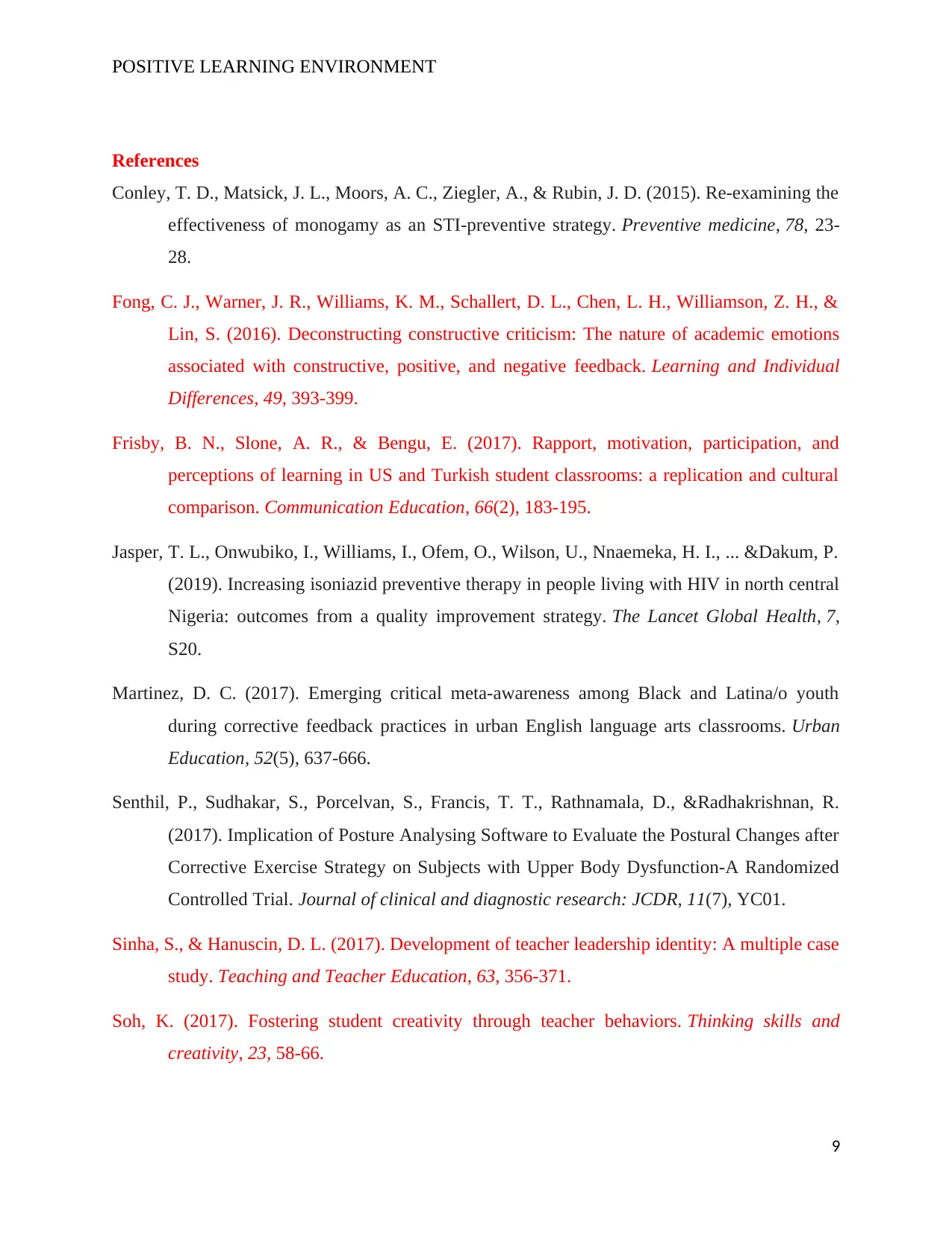
POSITIVE LEARNING ENVIRONMENT
References
Conley, T. D., Matsick, J. L., Moors, A. C., Ziegler, A., & Rubin, J. D. (2015). Re-examining the
effectiveness of monogamy as an STI-preventive strategy. Preventive medicine, 78, 23-
28.
Fong, C. J., Warner, J. R., Williams, K. M., Schallert, D. L., Chen, L. H., Williamson, Z. H., &
Lin, S. (2016). Deconstructing constructive criticism: The nature of academic emotions
associated with constructive, positive, and negative feedback. Learning and Individual
Differences, 49, 393-399.
Frisby, B. N., Slone, A. R., & Bengu, E. (2017). Rapport, motivation, participation, and
perceptions of learning in US and Turkish student classrooms: a replication and cultural
comparison. Communication Education, 66(2), 183-195.
Jasper, T. L., Onwubiko, I., Williams, I., Ofem, O., Wilson, U., Nnaemeka, H. I., ... &Dakum, P.
(2019). Increasing isoniazid preventive therapy in people living with HIV in north central
Nigeria: outcomes from a quality improvement strategy. The Lancet Global Health, 7,
S20.
Martinez, D. C. (2017). Emerging critical meta-awareness among Black and Latina/o youth
during corrective feedback practices in urban English language arts classrooms. Urban
Education, 52(5), 637-666.
Senthil, P., Sudhakar, S., Porcelvan, S., Francis, T. T., Rathnamala, D., &Radhakrishnan, R.
(2017). Implication of Posture Analysing Software to Evaluate the Postural Changes after
Corrective Exercise Strategy on Subjects with Upper Body Dysfunction-A Randomized
Controlled Trial. Journal of clinical and diagnostic research: JCDR, 11(7), YC01.
Sinha, S., & Hanuscin, D. L. (2017). Development of teacher leadership identity: A multiple case
study. Teaching and Teacher Education, 63, 356-371.
Soh, K. (2017). Fostering student creativity through teacher behaviors. Thinking skills and
creativity, 23, 58-66.
9
References
Conley, T. D., Matsick, J. L., Moors, A. C., Ziegler, A., & Rubin, J. D. (2015). Re-examining the
effectiveness of monogamy as an STI-preventive strategy. Preventive medicine, 78, 23-
28.
Fong, C. J., Warner, J. R., Williams, K. M., Schallert, D. L., Chen, L. H., Williamson, Z. H., &
Lin, S. (2016). Deconstructing constructive criticism: The nature of academic emotions
associated with constructive, positive, and negative feedback. Learning and Individual
Differences, 49, 393-399.
Frisby, B. N., Slone, A. R., & Bengu, E. (2017). Rapport, motivation, participation, and
perceptions of learning in US and Turkish student classrooms: a replication and cultural
comparison. Communication Education, 66(2), 183-195.
Jasper, T. L., Onwubiko, I., Williams, I., Ofem, O., Wilson, U., Nnaemeka, H. I., ... &Dakum, P.
(2019). Increasing isoniazid preventive therapy in people living with HIV in north central
Nigeria: outcomes from a quality improvement strategy. The Lancet Global Health, 7,
S20.
Martinez, D. C. (2017). Emerging critical meta-awareness among Black and Latina/o youth
during corrective feedback practices in urban English language arts classrooms. Urban
Education, 52(5), 637-666.
Senthil, P., Sudhakar, S., Porcelvan, S., Francis, T. T., Rathnamala, D., &Radhakrishnan, R.
(2017). Implication of Posture Analysing Software to Evaluate the Postural Changes after
Corrective Exercise Strategy on Subjects with Upper Body Dysfunction-A Randomized
Controlled Trial. Journal of clinical and diagnostic research: JCDR, 11(7), YC01.
Sinha, S., & Hanuscin, D. L. (2017). Development of teacher leadership identity: A multiple case
study. Teaching and Teacher Education, 63, 356-371.
Soh, K. (2017). Fostering student creativity through teacher behaviors. Thinking skills and
creativity, 23, 58-66.
9
⊘ This is a preview!⊘
Do you want full access?
Subscribe today to unlock all pages.

Trusted by 1+ million students worldwide
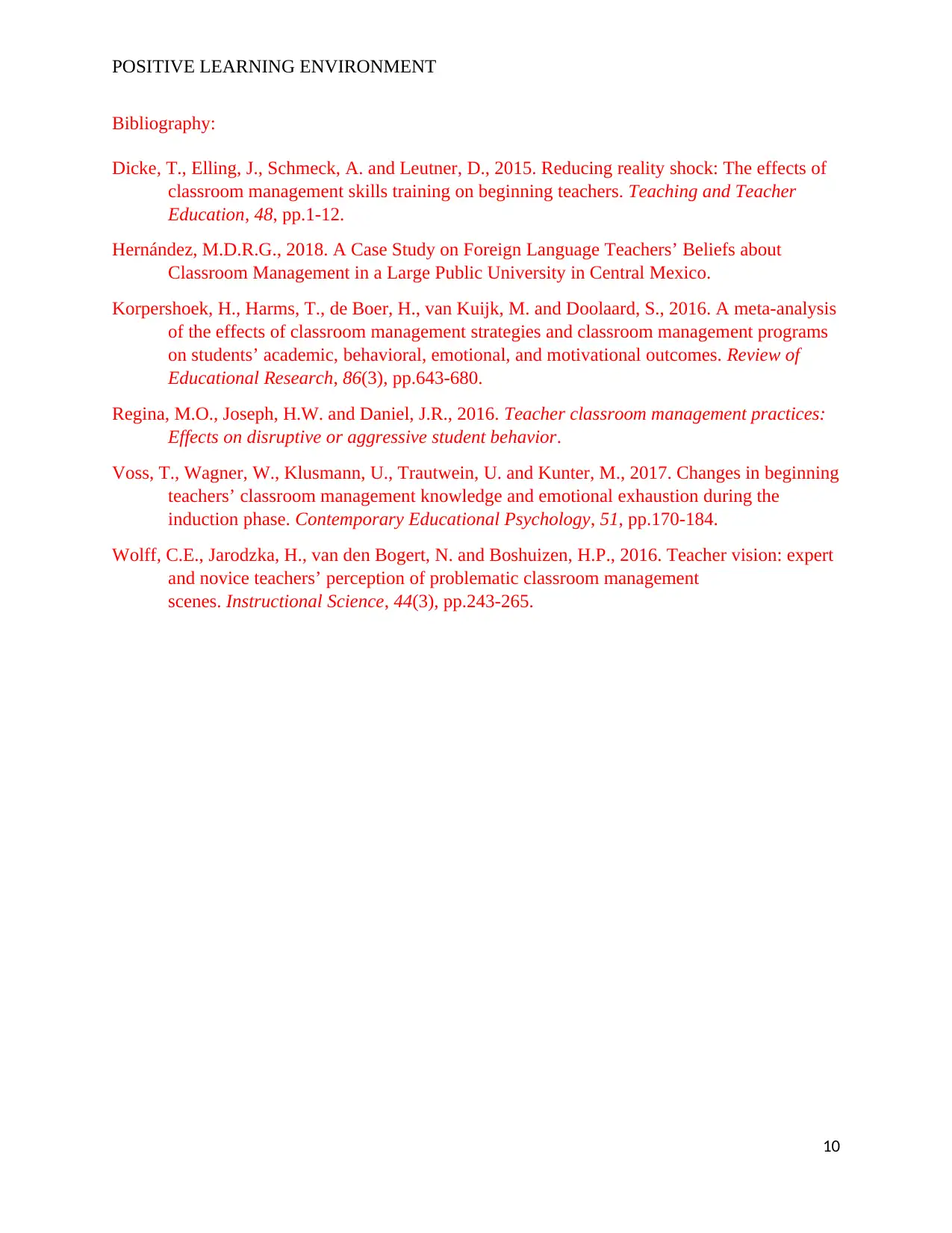
POSITIVE LEARNING ENVIRONMENT
Bibliography:
Dicke, T., Elling, J., Schmeck, A. and Leutner, D., 2015. Reducing reality shock: The effects of
classroom management skills training on beginning teachers. Teaching and Teacher
Education, 48, pp.1-12.
Hernández, M.D.R.G., 2018. A Case Study on Foreign Language Teachers’ Beliefs about
Classroom Management in a Large Public University in Central Mexico.
Korpershoek, H., Harms, T., de Boer, H., van Kuijk, M. and Doolaard, S., 2016. A meta-analysis
of the effects of classroom management strategies and classroom management programs
on students’ academic, behavioral, emotional, and motivational outcomes. Review of
Educational Research, 86(3), pp.643-680.
Regina, M.O., Joseph, H.W. and Daniel, J.R., 2016. Teacher classroom management practices:
Effects on disruptive or aggressive student behavior.
Voss, T., Wagner, W., Klusmann, U., Trautwein, U. and Kunter, M., 2017. Changes in beginning
teachers’ classroom management knowledge and emotional exhaustion during the
induction phase. Contemporary Educational Psychology, 51, pp.170-184.
Wolff, C.E., Jarodzka, H., van den Bogert, N. and Boshuizen, H.P., 2016. Teacher vision: expert
and novice teachers’ perception of problematic classroom management
scenes. Instructional Science, 44(3), pp.243-265.
10
Bibliography:
Dicke, T., Elling, J., Schmeck, A. and Leutner, D., 2015. Reducing reality shock: The effects of
classroom management skills training on beginning teachers. Teaching and Teacher
Education, 48, pp.1-12.
Hernández, M.D.R.G., 2018. A Case Study on Foreign Language Teachers’ Beliefs about
Classroom Management in a Large Public University in Central Mexico.
Korpershoek, H., Harms, T., de Boer, H., van Kuijk, M. and Doolaard, S., 2016. A meta-analysis
of the effects of classroom management strategies and classroom management programs
on students’ academic, behavioral, emotional, and motivational outcomes. Review of
Educational Research, 86(3), pp.643-680.
Regina, M.O., Joseph, H.W. and Daniel, J.R., 2016. Teacher classroom management practices:
Effects on disruptive or aggressive student behavior.
Voss, T., Wagner, W., Klusmann, U., Trautwein, U. and Kunter, M., 2017. Changes in beginning
teachers’ classroom management knowledge and emotional exhaustion during the
induction phase. Contemporary Educational Psychology, 51, pp.170-184.
Wolff, C.E., Jarodzka, H., van den Bogert, N. and Boshuizen, H.P., 2016. Teacher vision: expert
and novice teachers’ perception of problematic classroom management
scenes. Instructional Science, 44(3), pp.243-265.
10
Paraphrase This Document
Need a fresh take? Get an instant paraphrase of this document with our AI Paraphraser
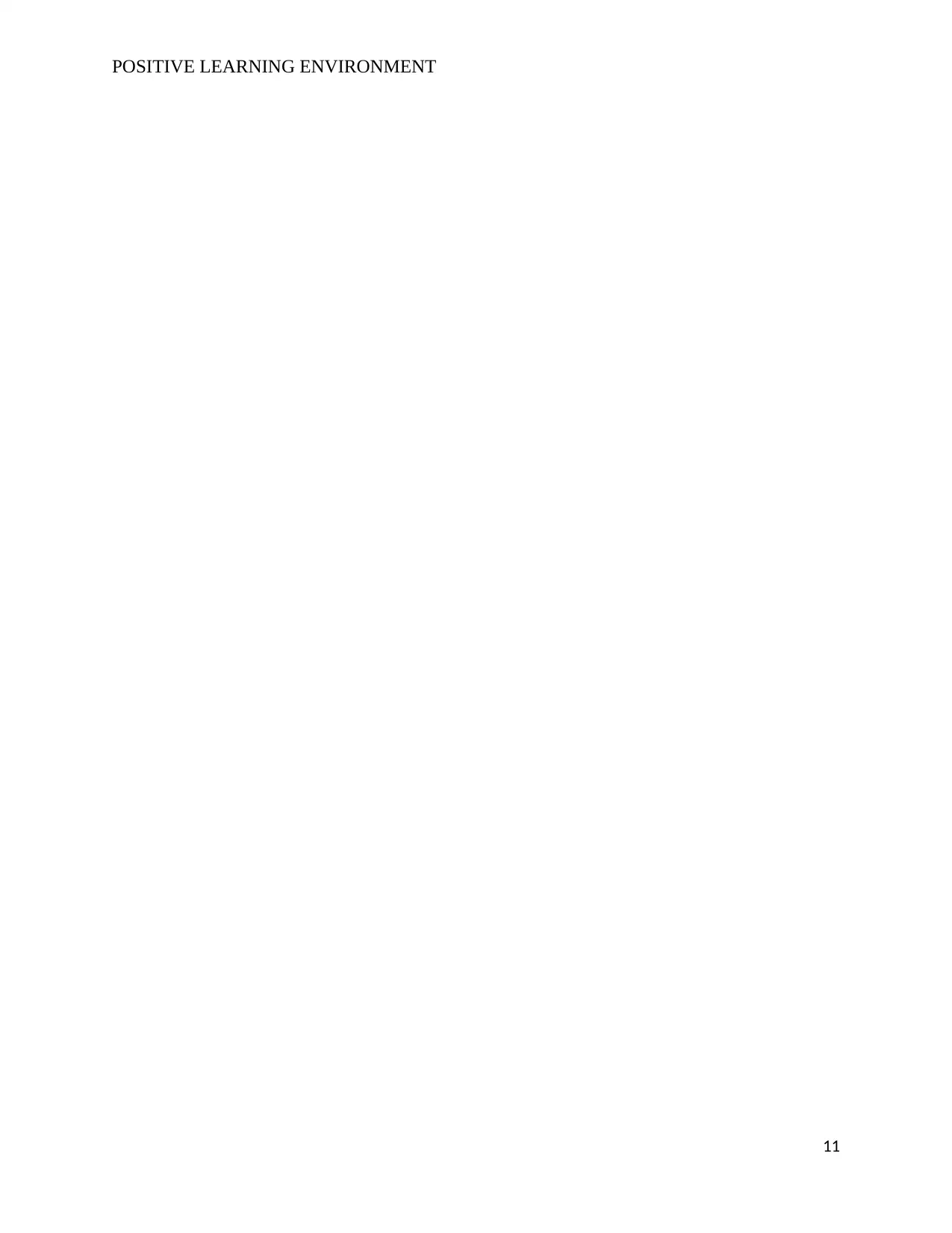
POSITIVE LEARNING ENVIRONMENT
11
11
1 out of 11
Related Documents
Your All-in-One AI-Powered Toolkit for Academic Success.
+13062052269
info@desklib.com
Available 24*7 on WhatsApp / Email
![[object Object]](/_next/static/media/star-bottom.7253800d.svg)
Unlock your academic potential
Copyright © 2020–2025 A2Z Services. All Rights Reserved. Developed and managed by ZUCOL.





